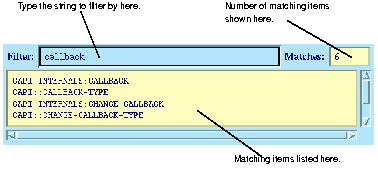






3 Common Features
Such lists are often very long, and there may be information displayed which you are not interested in. For instance, Common Lisp objects may contain a large number of slots, most of which are of no importance to your work.
Very often a list is accompanied by a Filter area which lets you hide such redundant information. Filter areas consist of a pane into which you can type a string of text, as shown below, and are always positioned immediately above the list on which the Filter area operates.

Figure 3.2 Example Filter area
To use a Filter area, type in a text string and press the Return key. Only those items which contain the specified string are displayed in the list -- all the others are hidden from the display. The number of items that are listed is printed in the Matches area to the right of the Filter area.
To display all the items in a list once again, delete the string in the Filter area and press Return.






Generated with Harlequin WebMaker